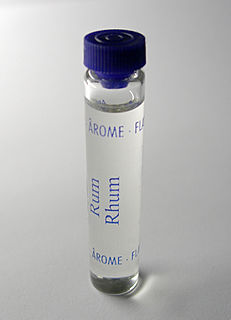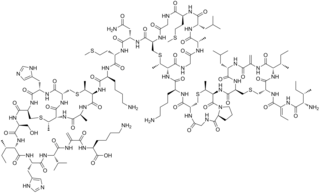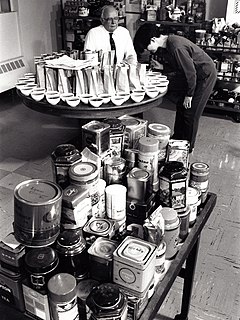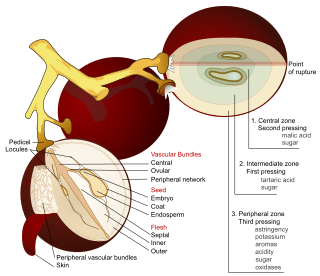Related Research Articles

A flavoring, also known as flavor or flavorant, is a food additive used to improve the taste or smell of food. It changes the perceptual impression of food as determined primarily by the chemoreceptors of the gustatory and olfactory system. Along with additives, other components like sugars determine the taste of food.

Ultra-high temperature processing (UHT), ultra-heat treatment, or ultra-pasteurization is a food processing technology that sterilizes liquid food by heating it above 135 °C (275 °F) – the temperature required to kill bacterial endospores – for 2 to 5 seconds. UHT is most commonly used in milk production, but the process is also used for fruit juices, cream, soy milk, yogurt, wine, soups, honey, and stews. UHT milk was first developed in the 1960s and became generally available for consumption in the 1970s.

Nisin is a polycyclic antibacterial peptide produced by the bacterium Lactococcus lactis that is used as a food preservative. It has 34 amino acid residues, including the uncommon amino acids lanthionine (Lan), methyllanthionine (MeLan), didehydroalanine (Dha), and didehydroaminobutyric acid (Dhb). These unusual amino acids are introduced by posttranslational modification of the precursor peptide. In these reactions a ribosomally synthesized 57-mer is converted to the final peptide. The unsaturated amino acids originate from serine and threonine, and the enzyme-catalysed addition of cysteine residues to the didehydro amino acids result in the multiple (5) thioether bridges.

Grappa is an alcoholic beverage: a fragrant, grape-based pomace brandy of Italian origin that contains 35 to 60 percent alcohol by volume.

Wine and food matching is the process of pairing food dishes with wine to enhance the dining experience. In many cultures, wine has had a long history of being a staple at the dinner table and in some ways both the winemaking and culinary traditions of a region will have evolved together over the years. Rather than following a set of rules, local cuisines were paired simply with local wines. The modern "art" of food pairings is a relatively recent phenomenon, fostering an industry of books and media with guidelines for pairings of particular foods and wine. In the restaurant industry, sommeliers are often present to make food pairing recommendations for the guest. The main concept behind pairings is that certain elements in both food and wine interact with each other, and thus finding the right combination of these elements will make the entire dining experience more enjoyable. However, taste and enjoyment are very subjective and what may be a "textbook perfect" pairing for one taster could be less enjoyable to another.
Aftertaste is the taste intensity of a food or beverage that is perceived immediately after that food or beverage is removed from the mouth. The aftertastes of different foods and beverages can vary by intensity and over time, but the unifying feature of aftertaste is that it is perceived after a food or beverage is either swallowed or spat out. The neurobiological mechanisms of taste signal transduction from the taste receptors in the mouth to the brain have not yet been fully understood. However, the primary taste processing area located in the insula has been observed to be involved in aftertaste perception.

Modern American cheese is a type of processed cheese developed in the 1910s made from cheddar, Colby, or similar cheeses. It is mild with a creamy and salty flavor, has a medium-firm consistency, and has a low melting point. It is typically yellow or white in color; yellow American cheese is seasoned and colored with annatto.

Easy Cheese is the trademark for a processed cheese spread product distributed by Mondelēz International. It is also referred to as "spray cheese", "cheese fizz", or simply "cheese in a can", and is similar to "squeeze cheese". Easy Cheese is packaged in a metal can filled with air covered with a plastic cap that reveals a straight, flexible nozzle where the cheese is extruded.
Sensory analysis is a scientific discipline that applies principles of experimental design and statistical analysis to the use of human senses for the purposes of evaluating consumer products. The discipline requires panels of human assessors, on whom the products are tested, and recording the responses made by them. By applying statistical techniques to the results it is possible to make inferences and insights about the products under test. Most large consumer goods companies have departments dedicated to sensory analysis. Sensory analysis can mainly be broken down into three sub-sections:
A wine fault or defect is an unpleasant characteristic of a wine often resulting from poor winemaking practices or storage conditions, and leading to wine spoilage. Many of the compounds that cause wine faults are already naturally present in wine but at insufficient concentrations to be of issue. In fact, depending on perception, these concentrations may impart positive characters to the wine. However, when the concentration of these compounds greatly exceeds the sensory threshold, they replace or obscure the flavors and aromas that the wine should be expressing. Ultimately the quality of the wine is reduced, making it less appealing and sometimes undrinkable.
The odor detection threshold is the lowest concentration of a certain odor compound that is perceivable by the human sense of smell. The threshold of a chemical compound is determined in part by its shape, polarity, partial charges, and molecular mass. The olfactory mechanisms responsible for a compound's different detection threshold is not well understood. As such, odor thresholds cannot be accurately predicted. Rather, they must be measured through extensive tests using human subjects in laboratory settings.

Mouthfeel refers to the physical sensations in the mouth caused by food or drink, making it distinct from taste. It is a fundamental sensory attribute which, along with taste and smell, determines the overall flavor of a food item. Mouthfeel is also sometimes referred to as texture.
Coffee cupping, or coffee tasting, is the practice of observing the tastes and aromas of brewed coffee. It is a professional practice but can be done informally by anyone or by professionals known as "Q Graders". A standard coffee cupping procedure involves deeply sniffing the coffee, then slurping the coffee from a spoon so it is aerated and spread across the tongue. The coffee taster attempts to measure aspects of the coffee's taste, specifically the body, sweetness, acidity, flavour, and aftertaste. Since coffee beans embody telltale flavours from the region where they were grown, cuppers may attempt to identify the coffee's origin.

Tea tasting is the process in which a trained taster determines the quality of a particular tea. Due to climatic conditions, topography, manufacturing process, and different cultivars of the Camellia sinensis plant (tea), the final product may have vastly differing flavours and appearance. These differences can be tasted by a trained taster in order to ascertain the quality prior to sale or possibly blending tea.
Ann C. Noble is a sensory chemist and retired professor from the University of California, Davis. During her time at the UC Davis Department of Viticulture and Enology, Noble invented the "Aroma Wheel" which is credited with enhancing the public understanding of wine tasting and terminology. At the time of her hiring at UC Davis in 1974, Noble was the first woman hired as a faculty member of the Viticulture department. Noble retired from Davis in 2002 and in 2003 was named Emeritus Professor of Enology. Since retirement she has participated as a judge in the San Francisco Chronicle Wine Competition.

The acids in wine are an important component in both winemaking and the finished product of wine. They are present in both grapes and wine, having direct influences on the color, balance and taste of the wine as well as the growth and vitality of yeast during fermentation and protecting the wine from bacteria. The measure of the amount of acidity in wine is known as the “titratable acidity” or “total acidity”, which refers to the test that yields the total of all acids present, while strength of acidity is measured according to pH, with most wines having a pH between 2.9 and 3.9. Generally, the lower the pH, the higher the acidity in the wine. There is no direct connection between total acidity and pH. In wine tasting, the term “acidity” refers to the fresh, tart and sour attributes of the wine which are evaluated in relation to how well the acidity balances out the sweetness and bitter components of the wine such as tannins. Three primary acids are found in wine grapes: tartaric, malic, and citric acids. During the course of winemaking and in the finished wines, acetic, butyric, lactic, and succinic acids can play significant roles. Most of the acids involved with wine are fixed acids with the notable exception of acetic acid, mostly found in vinegar, which is volatile and can contribute to the wine fault known as volatile acidity. Sometimes, additional acids, such as ascorbic, sorbic and sulfurous acids, are used in winemaking.

Wine tasting is the sensory examination and evaluation of wine. While the practice of wine tasting is as ancient as its production, a more formalized methodology has slowly become established from the 14th century onward. Modern, professional wine tasters use a constantly evolving specialized terminology which is used to describe the range of perceived flavors, aromas and general characteristics of a wine. More informal, recreational tasting may use similar terminology, usually involving a much less analytical process for a more general, personal appreciation.

The aromas of wine are more diverse than its flavors. The human tongue is limited to the primary tastes perceived by taste receptors on the tongue – sourness, bitterness, saltiness, sweetness and savoriness. The wide array of fruit, earthy, leathery, floral, herbal, mineral, and woodsy flavor present in wine are derived from aroma notes sensed by the olfactory bulb. In wine tasting, wine is sometimes smelled before taking a sip in order to identify some components of the wine that may be present. Different terms are used to describe what is being smelled. The most basic term is aroma which generally refers to a "pleasant" smell as opposed to odor which refers to an unpleasant smell or possible wine fault. The term aroma may be further distinguished from bouquet which generally refers to the smells that arise from the chemical reactions of fermentation and aging of the wine.
Neurogastronomy is the study of flavor perception and the ways it affects cognition and memory. This interdisciplinary field is influenced by the psychology and neuroscience of sensation, learning, satiety, and decision making. Areas of interest include how olfaction contributes to flavor, food addiction and obesity, taste preferences, and the linguistics of communicating and identifying flavor. The term neurogastronomy was coined by neuroscientist Gordon M. Shepherd.
Joanne Hort is a New Zealand food science academic, and as of 2019 is a full professor at the Massey University and holds the 'Fonterra Riddet Chair in Consumer and Sensory Science'.
References
- ↑ Drake, MA (2002). "Flavor Lexicons" (PDF). Comprehensive Reviews in Food Science and Food Safety. 2: 33–40. doi: 10.1111/j.1541-4337.2003.tb00013.x . Retrieved April 22, 2017.
- ↑ Drake, MA (2002). "Flavor Lexicons" (PDF). Comprehensive Reviews in Food Science and Food Safety. 2: 33–40. doi: 10.1111/j.1541-4337.2003.tb00013.x . Retrieved April 22, 2017.
- ↑ Drake, MA (2002). "Flavor Lexicons" (PDF). Comprehensive Reviews in Food Science and Food Safety. 2: 33–40. doi: 10.1111/j.1541-4337.2003.tb00013.x . Retrieved April 22, 2017.
- ↑ Drake, MA (2002). "Flavor Lexicons" (PDF). Comprehensive Reviews in Food Science and Food Safety. 2: 33–40. doi: 10.1111/j.1541-4337.2003.tb00013.x . Retrieved April 22, 2017.
- ↑ Long, Lucy (December 14, 2015). "Definition of Food Culture". Lexicon of Food. Retrieved April 30, 2017.
- ↑ Drake, MA (November 2001). "Development of a Descriptive Language for Cheddar Cheese". Journal of Food Science. 66 (9): 1422–1427. doi:10.1111/j.1365-2621.2001.tb15225.x.
- ↑ Chambers, Edgar. "Coffee sensory dictionary developed at Kansas State University". Kansas State University. Kansas State University.